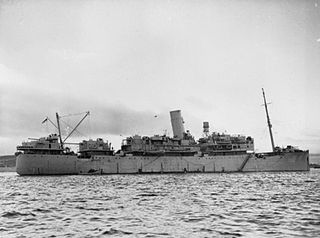
HMS Cheshire was a passenger ship that was built in Scotland in 1927 and scrapped in Wales in 1957. She belonged to Bibby Line, which ran passenger and cargo services between Rangoon in Burma and various ports in Great Britain, via the Suez Canal and Gibraltar. The Admiralty requisitioned her in 1939 and had her converted into an armed merchant cruiser (AMC). She was converted into a troopship in 1943, and returned to civilian service in 1948.

Ryusei Maru was a cargo steamship that was built in England in 1911 and sunk off the coast of Bali in 1944. She was launched as Bra-Kar for Fred. Olsen & Co. of Norway. In 1916 she changed owners and was renamed Havø. In 1935 she changed owners again and was renamed Mabuhay II.

SS Clearton was a cargo steamship that was built in England in 1919 and sunk in the Battle of the Atlantic in 1940. The UK Shipping Controller ordered her, and she was built to War Standard design Type B. R Chapman and Sons of Newcastle upon Tyne operated her throughout her working life.
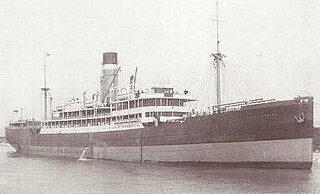
SS City of Venice was an intermediate ocean liner that was launched in 1924 in Northern Ireland for Ellerman Lines. In the Second World War she was a troop ship. In 1943 a U-boat sank her in the Mediterranean, killing 22 of the crew and troops aboard.

SS Corinthic was a British cargo steamship. She was built on Teesside in 1924, sailed in a number of convoys in the Second World War, survived an overwhelming German attack on Convoy SC 7 October 1940, but was sunk by a German U-boat off West Africa in April 1941.

SS Fiscus was a UK cargo steamship that was built in 1928, served in the Second World War and was sunk by a U-boat in 1940.
SS Tregenna was a cargo steamship that was launched in England in 1919 and sunk by a U-boat in the Battle of the Atlantic in 1940 with the loss of 33 of her 37 crew. She was laid down as War Bulldog, but the Hain Steam Ship Co bought her before she was completed and renamed her Tregenna.
MV Domala was a British cargo liner that was launched in 1920 as Magvana, but completed in 1921 as Domala. She was the first major ocean-going passenger ship to be built in the United Kingdom as a motor ship.
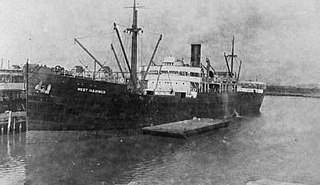
SS West Maximus was a steel-hulled cargo ship built for the United States Shipping Board's emergency wartime construction program during World War I. Completed too late to see service in the war, West Maximus spent the interwar years in commercial service.
SS Canonesa was a refrigerated cargo steamship that was built in Ireland in 1920 and sunk by a u-boat in the Atlantic Ocean in 1940.
SS Hertford was a refrigerated cargo steamship that was launched in Germany in 1917, seized by the United Kingdom in 1920 as World War I reparations, and sunk by a U-boat in 1942 with the loss of four members of her crew.
SS Aguila was a British steam passenger liner. She was built in Dundee in 1917 and was sunk by enemy action in the North Atlantic in 1941. She belonged to Yeoward Line, which carried passengers and fruit between Liverpool, Lisbon, Madeira and the Canary Islands.
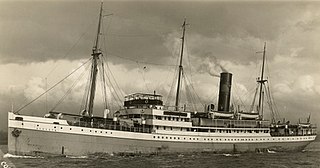
SS Avoceta was a British steam passenger liner. She was built in Dundee in 1923 and was sunk by enemy action in the North Atlantic in 1941. She belonged to Yeoward Line, which carried passengers and fruit between Liverpool, Lisbon, Madeira and the Canary Islands.
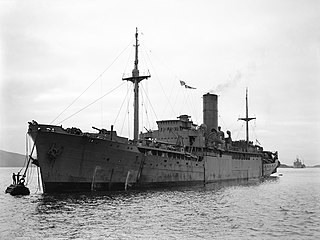
HMS Agamemnon was originally the Blue Funnel Line refrigerated cargo ship Agamemnon. She was built in 1929, traded between the UK and the Far East, and was scrapped in 1963. During the Second World War she was converted into an auxiliary minelayer in 1940, and then into an amenities ship in 1943.
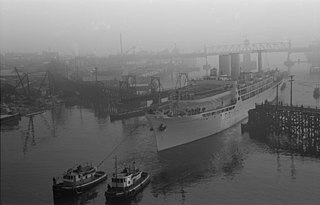
HMS Menestheus was originally the Blue Funnel Line refrigerated cargo ship Menestheus. She was built in 1929, and traded between the UK and the Far East. She was an auxiliary minelayer from 1940 to 1943. In 1945, during the Second World War, she was converted into an amenities ship. She was scrapped in 1953 after being gutted by fire.

Wentworth was a British cargo steamship that was built in 1919 as War Phlox. The UK Shipping Controller ordered her, and she was built to War Standard design Type A. The Dalgliesh Shipping Company of Newcastle upon Tyne bought her when new, renamed her Wentworth, and owned her throughout her working life. She was sunk in the North Atlantic in 1943 during the Battle of the Atlantic, with the loss of five of her 47 crew.
SS Benlomond was a British cargo steamship that was built in 1922 as Cynthiana, changed owners and names a number of times, and was sunk by a U-boat in 1942, with the loss of all but one of her 53 ship's company. The sole survivor, Poon Lim, drifted on a raft for 133 days before being rescued.
SS Tregarthen was a cargo steamship that was built in Scotland for the Hain Steam Ship Co in 1936. She was sunk with all hands by a U-boat in 1941 in the Battle of the Atlantic.
SS Hartlebury was a cargo steamship that was launched in Scotland in 1934 for J&C Harrison Ltd. A U-boat sank her in the Barents Sea in 1942 when Hartlebury was a member of the Arctic convoy Convoy PQ 17.

MV Deucalion was a Blue Funnel Line refrigerated cargo ship that was built in England in 1930 and sunk in the Second World War in 1942. She survived being damaged in the Liverpool Blitz in December 1940 and took part in two Malta convoys to relieve the Siege of Malta. She survived air attacks during the first of these, Operation Substance, in July 1941 but was lost on her second Malta Convoy, Operation Pedestal, in August 1942. This was the third of five Blue Funnel ships to be named after Deucalion, a mythological king of Thessaly in Ancient Greece.














